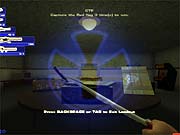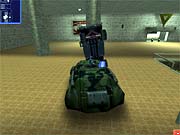Pretty much everyone agrees that adding drivable vehicles to the on-foot gameplay of a traditional shooter is a cool idea. But other than a few attempts--the initially buggy and relatively little-known Codename: Eagle being the most notable--not many developers have tried it, much less pulled it off. Mobile Forces is the most recent of these rare attempts to meaningfully integrate vehicles and pedestrians. Though it could have used some more polishing, balancing, and improved network code, it generally succeeds on its own terms and is arguably one of the most successful games of this type to date.

The game's handheld weapons aren't especially original. There's a pistol, a shotgun, a machine gun, a sniper rifle, grenades, trip mines, rocket launchers, and a slightly exotic mounted Gatling gun. These are all secondary to Mobile Forces' real draw, its four vehicles. The dune buggy is fast and lightly armored, and it includes a driver position and a rear-mounted platform for a single gunner. Slightly slower but more resistant to damage, the Humvee can fit a driver and a passenger in the cab and has two gunner nests mounted on top. The troop transport features driver and passenger positions, plus room for four people in back. Finally, the armored car is slow and tough and can fit only a driver and one gunner.
Mobile Forces has a number of different game types: deathmatch, team deathmatch, a version of team deathmatch in which you only score points for killing the opposing team's captain, capture and hold, and four capture-the-flag variants. Notably absent is any sort of combat racing mode, though Mobile Forces' best game type, a capture-the-flag variant called "trailer," almost makes up for that. In trailer, a giant bomb sitting in the eponymous trailer is attached to a Humvee parked somewhere on the level. To score, either team must capture the Humvee and then drive it into the opposing team's base. It's the only game mode in which the goal is specifically vehicle-based, and it sets up some wild chases as one convoy of armed vehicles protects the captured trailer while another group attempts to stop it.
Each of the game's 11 levels supports all eight game types. For the most part, the levels are huge. They all tend to follow a similar design theme: two bases and a central hub area connected by a long, twisty landscape designed to be navigated by vehicles, plus a shorter path that cuts across the folds but can only be traversed on foot. Mobile Forces uses the Unreal Tournament-era Unreal engine, and, despite the large size of the environments, the texture work is surprisingly detailed. The levels take place in a wide variety of unrelated but nicely rendered settings. An urban ghetto, a polar outpost with an ice-bound submarine in the middle, and a pair of violently opposed logging camps are the standouts. The weapon models, on the other hand, are uniformly awful. The car models are fine, but unfortunately, the damage modeling on them isn't. Black smoke is the only real indication that a vehicle is taking damage. It's a glaring omission in a game that relies so heavily on the thrill of smashing cars into each other.
Damage modeling aside, Mobile Forces' vehicles have a lot of nice touches. The unrealistic, arcadelike feel of the physics engine complements the fast-paced nature of the game. The cars feature independent suspension, and a well-placed shot can take out an individual tire, causing the vehicle to spin out. If a car is moving slowly enough, you can hop into the passenger seat and shoot the driver. You can even destroy a vehicle in one shot if you hit its gas cap using the sniper rifle. But that's not likely to happen, because the game's weapons are so unbalanced that you'll probably never even carry a sniper rifle. The only really viable weapon is the rocket launcher. It does splash damage, can home in on a target, and even features a sniper scope in secondary fire mode. It's the only effective weapon against vehicles, and it works well on soft targets too. Since there's no suicide key and since the goal of several of the CTF modes (including trailer) is to penetrate the enemy's base, the rocket launcher is also the best way to kill yourself if you get stuck out in the middle of nowhere without a ride while an opponent drives toward your base--which conveniently also happens to be your respawn spot.

Mobile Forces' single-player game is just a series of bot matches. The bot AI is pretty good, however. The bots know how to drive and ride in vehicles, and rather than simply getting more accurate, they actually appear to make more intelligent choices at higher levels. Still, they have some exploitable gaps in their behavior, such as not realizing that they shouldn't walk through trip mines. They also don't understand that they shouldn't take any weapon other than the rocket launcher, which means you'll end up with half-useless teammates carrying Gatling guns and sniper rifles. The bot matches are challenging, but not for very long.
If you can find a decent server, a stable connection, and enough people to play with, multiplayer is where Mobile Forces shines. There's a built-in server browser, but there aren't many servers to browse at this point. It's always tough to predict whether a game will catch on or not, but in this case there's at least one good indicator: After being out in Europe for over a month, there still aren't more than 10 or 15 active servers on average, and these are generally empty. It's also difficult to accurately judge the game's network code with such a limited sampling of servers, but so far it's been pretty spotty, even on servers that show a low ping.
Whether it ever attracts an audience, Mobile Forces is solid and unique enough to deserve one. The vehicles work well, they're fun to drive, and they end up overshadowing the game's weapon-balancing issues. It's very similar to the popular Rocket Arena modification for Quake, but with cars. A good round of trailer is the closest that any game has come to re-creating the final chase scene of The Road Warrior.